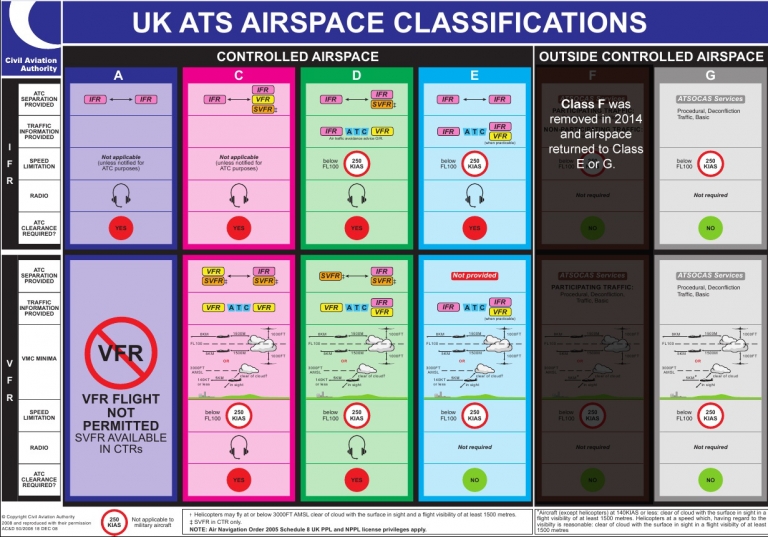United Kingdom Division
 In the UK, we have 5 different classifications of airspace in use; A, C, D, E, G. The classification of the airspace within a FIR determines the flight rules which apply and the minimum air traffic services which are to be provided. These allow us to better manage traffic flow, and ensure only the appropriate aircraft are in places they should be in.
In the UK, we have 5 different classifications of airspace in use; A, C, D, E, G. The classification of the airspace within a FIR determines the flight rules which apply and the minimum air traffic services which are to be provided. These allow us to better manage traffic flow, and ensure only the appropriate aircraft are in places they should be in.
The 5 classifications can be broken down into Controlled Airspace (A, C, D & E) and Outside Controlled Airspace (G). The use of Class F airspace was stopped in 2014, and as such Class G is the only OCAS classification.
At first glance, the chart on the right can seem daunting. It can be broken-down into smaler chunks, so that it's easier to deal with.
The chart is divided top-bottom with IFR-VFR. This refers to the Instrument and Visual Flight Rules that an aircraft may fly under. Left and Right sides are divided into CAS and OCAS. Once again, only one class of airspace is available outside of controlled airspace.
Let's take a deeper dive into these classifications, and see what they're all about.
Class A airspace is the most restrictive; almost all of the airways and air-routes in the UK are covered by this classification. An Air Traffic Control Service is mandatory, and VFR is not permitted. Aircraft are separated from all other users of this airspace.
| ATC Separation Provided | IFR - IFR | Aircraft travelling under IFR must be separated from eachother. |
|---|---|---|
| Traffic Information Provided | No | No traffic information provided. |
| Speed Limitation | N/A | No speed limit unless otherwise instructed by ATC. |
| Radio | Mandatory | The aircraft must be equipped with a radio. |
| ATC Clearance Required? | Yes | The aircraft must receive clearance from ATC before entering this class airspace. |
VFR Flight is Not Permitted
Class C airspace in the UK extends from Flight Level (FL) 195 (19,500 feet) to FL 600 (60,000 feet). Both IFR and Visual Flight Rules (VFR) flying is permitted.
| ATC Separation Provided |
IFR - IFR IFR - VFR IFR - SVFR |
Aircraft travelling under IFR must be separated from eachother, as well as aircraft travelling under VFR and SVFR. |
|---|---|---|
| Traffic Information Provided | No | No traffic information provided. |
| Speed Limitation | N/A | No speed limit unless otherwise instructed by ATC. |
| Radio | Mandatory | The aircraft must be equipped with a radio. |
| ATC Clearance Required? | Yes | The aircraft must receive clearance from ATC before entering this class airspace. |
| ATC Separation Provided |
VFR - IFR SVFR - SVFR |
Aircraft travelling under VFR will be separated from IFR traffic. They will not be separated from eachother. Aircraft under SVFR will be separated from eachother, as well as IFR. |
|---|---|---|
| Traffic Information Provided | VFR - VFR | Aircraft travelling under VFR will receive traffic infromation about other VFR aircraft. |
| VMC Minima |
At and above FL 100: 8 km flight visibility, 1,500 m horizontally from cloud, 1,000 ft (300m) vertically from cloud Below FL 100: 5 km flight visibility, 1,500 m horizontally from cloud, 1,000 ft (300m) vertically from cloud Alternatively at or below 3,000 and operating at 140kt or less ft: For helicopters: Clear of cloud and in sight of surface with a flight visibility of 1500m |
|
| Speed Limitation | 250kts Below FL100 | Aircraft travelling below FL100 must comply with a 250kts speed limit, unless authorised to exceed by ATC. |
| Radio | Mandatory | The aircraft must be equipped with a radio. |
| ATC Clearance Required? | Yes | The aircraft must receive clearance from ATC before entering this class airspace. |
The most common classification surrounding aerodrome contol zones, class D airspace can be used by both IFR and VFR aircraft. They must comply with a speed limit of 250kts below FL100, and traffic information will be provided to IFR and VFR aircraft.
| ATC Separation Provided |
IFR - IFR IFR - SVFR |
Aircraft travelling under IFR must be separated from eachother, as well as aircraft travelling under SVFR. They will not be separated from VFR traffic. |
|---|---|---|
| Traffic Information Provided |
IFR - VFR |
Aircraft travelling under IFR must be given traffic information of other airborne VFR aircraft. Once complete, the aircraft are resonsible for providing their own separation. |
| Speed Limitation | 250kts Below FL100 | Aircraft travelling below FL100 must comply with a 250kts speed limit, unless authorised to exceed by ATC. |
| Radio | Mandatory | The aircraft must be equipped with a radio. |
| ATC Clearance Required? | Yes | The aircraft must receive clearance from ATC before entering this class airspace. |
| ATC Separation Provided |
SVFR - IFR SVFR - SVFR |
Aircraft travelling under SVFR will be separated from IFR traffic and eachother. |
|---|---|---|
| Traffic Information Provided |
VFR - VFR VFR - IFR |
Aircraft travelling under VFR will receive traffic infromation about other VFR aircraft, as well as IFR aircraft in the airspace. |
| VMC Minima |
At and above FL 100: 8 km flight visibility, 1,500 m horizontally from cloud, 1,000 ft (300m) vertically from cloud Below FL 100: 5 km flight visibility, 1,500 m horizontally from cloud, 1,000 ft (300m) vertically from cloud Alternatively at or below 3,000 and operating at 140kt or less ft: For helicopters: Clear of cloud and in sight of surface with a flight visibility of 1500m |
|
| Speed Limitation | 250kts Below FL100 | Aircraft travelling below FL100 must comply with a 250kts speed limit, unless authorised to exceed by ATC. |
| Radio | Mandatory | The aircraft must be equipped with a radio. |
| ATC Clearance Required? | Yes | The aircraft must receive clearance from ATC before entering this class airspace. |
Class E airspace is for IFR and VFR use. IFR aircraft require ATC clearance and compliance with ATC instructions is mandatory for separation purposes. VFR traffic does not require clearance to enter class E airspace.
| ATC Separation Provided |
IFR - IFR |
Aircraft travelling under IFR must be separated from eachother. They will not be separated from VFR traffic. |
|---|---|---|
| Traffic Information Provided |
IFR - IFR IFR - VFR |
Aircraft travelling under IFR must be given traffic information of other airborne VFR aircraft, and IFR aircraft. Once complete, the aircraft are resonsible for providing their own separation. |
| Speed Limitation | 250kts Below FL100 | Aircraft travelling below FL100 must comply with a 250kts speed limit, unless authorised to exceed by ATC. |
| Radio | Not Required | The aircraft does not need a radio to fly in this airspace. |
| ATC Clearance Required? | No | The aircraft is not obliged to receive clearance to fly into this airspace. |
| ATC Separation Provided | Not Provided | Aircraft travelling under VFR will not receive separation from any aircraft. |
|---|---|---|
| Traffic Information Provided |
VFR - VFR VFR - IFR |
Aircraft travelling under VFR will receive traffic infromation about other VFR aircraft, as well as IFR aircraft in the airspace. |
| VMC Minima |
At and above FL 100: 8 km flight visibility, 1,500 m horizontally from cloud, 1,000 ft (300m) vertically from cloud Below FL 100: 5 km flight visibility, 1,500 m horizontally from cloud, 1,000 ft (300m) vertically from cloud Alternatively at or below 3,000 and operating at 140kt or less ft: For helicopters: Clear of cloud and in sight of surface with a flight visibility of 1500m |
|
| Speed Limitation | 250kts Below FL100 | Aircraft travelling below FL100 must comply with a 250kts speed limit, unless authorised to exceed by ATC. |
| Radio | Not Required | The aircraft does not need a radio to fly in this airspace. |
| ATC Clearance Required? | No | The aircraft is not obliged to receive clearance to fly into this airspace. |
This is the least restrictive class of airspace. In class G airspace, aircraft may fly when and where they like, subject to a set of simple rules. Although there is no legal requirement to do so, many pilots notify Air Traffic Control of their presence and intentions. Pilots take full responsibility for their own safety, though can receive an ATSOCAS service.
| ATC Separation Provided | ATSOCAS Service Only | Aircraft will only be able to receive an ATSOCAS service. |
|---|---|---|
| Traffic Information Provided | ||
| Speed Limitation | 250kts Below FL100 | Aircraft travelling below FL100 must comply with a 250kts speed limit, unless authorised to exceed by ATC. |
| Radio | Not Required | The aircraft does not need a radio to fly in this airspace. |
| ATC Clearance Required? | No | The aircraft is not obliged to receive clearance to fly into this airspace. |
| ATC Separation Provided | ATSOCAS Service Only | Aircraft will only be able to receive an ATSOCAS service. |
|---|---|---|
| Traffic Information Provided | ||
| VMC Minima |
At and above FL 100: 8 km flight visibility, 1,500 m horizontally from cloud, 1,000 ft (300m) vertically from cloud Below FL 100: 5 km flight visibility, 1,500 m horizontally from cloud, 1,000 ft (300m) vertically from cloud Alternatively at or below 3,000 and operating at 140kt or less ft: For helicopters: Clear of cloud and in sight of surface with a flight visibility of 1500m |
|
| Speed Limitation | 250kts Below FL100 | Aircraft travelling below FL100 must comply with a 250kts speed limit, unless authorised to exceed by ATC. |
| Radio | Not Required | The aircraft does not need a radio to fly in this airspace. |
| ATC Clearance Required? | No | The aircraft is not obliged to receive clearance to fly into this airspace. |
